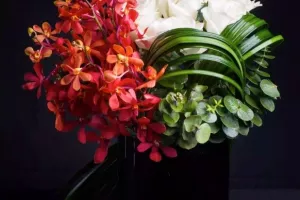The turn of the season too often means watching some of our favorite plants die after losing their ideal conditions and us heading back to the nursery to purchase new plants in hopes they will last longer. Instead of picking your plants by season, why not choose a few that will easily survive these transitions?
1. Coffee Trees
We can’t talk about versatile plants without discussing coffee trees. Planting the beans or seedlings of the arabica coffee plant is only the beginning of a long relationship. Coffee trees are a time investment, as it can take over a year to produce beans, so being able to move it between indoors and outdoors each year will allow you to consistently redesign your greenery while keeping a consistent plant in the mix. When you’re keeping your tree indoors, make sure it is getting plenty of direct sunlight and the soil is consistently moist. Humidity is also an important factor here, so setting your planter atop a pebble tray filled with water can help regulate a humid environment. Your coffee tree will enjoy the warmer temperatures and higher humidities of the summer months, and although they take some patience before they produce beans, they will display flowers and cherries far sooner, ensuring a beautiful decoration for indoors and outdoors alike.
2. Begonias
Begonia Rex is a great addition to your collection of indoor-outdoor plants because of its beautiful foliage. This plant loves to live indoors during colder months and can happily prosper outside when morning frosts have officially retired for the season. Begonia Rex boasts large, colorful leaves in shades of red, purple, silver, and green, adding dimension to your home and yard. Bright, indirect sunlight, as well as regular watering and misting, are important to maintain a healthy environment for this plant. During the warm seasons, keep your plant in a shady part of the yard or porch, and when indoors, place it on a non-south-facing window sill or under an LED grow light! Whether in your living room or on the back patio, with proper attention, your Begonia Rex will live happily for a couple of years – and when its prime has passed, you can easily propagate this plant to grow another!
3. Orchids
One of the most popular house plants, orchids are beautiful and make a great accent for interior design. While they are most commonly thought to be indoor flowers, they can easily thrive outdoors as well! Continue to water in the morning and provide ample humidity and airflow for your plant through the assistance of a pebble tray and a well-ventilated planter. Make sure you’re keeping your orchid in the shade when outdoors and stay alert for any extremely dry and/or hot days in case your orchid needs to come inside for a more regulated environment. Although they should not be left outdoors during a rainstorm at risk of flooding or root rot, once the rain stops your orchid will love the humidity left behind!
4. Boxwood Shrubs
Boxwood shrubs provide the traditional greenery of a shrub in a smaller form. These plants only grow roughly 2 feet tall, so they can work as a decoration for an outdoor patio or the floor of a sunroom – or any space with bright, direct sun exposure. Having this larger plant indoors will add variety to your collection and help avoid overcrowding on your windowsills by filling negative space in the room. In the early years of your boxwoods life, they will require weekly watering, and later they will need watering 1-2 times per month. Because of their compact size and shallow roots, there is no reason these shrubs cannot be easily moved between indoors and outdoors in their planters so long as if the temperatures get too high you are supplementing with extra water. Regardless of where you place them, occasional pruning is important to keep them looking fresh!
5. Tropical Hibiscus
A tropical hibiscus may not be the first plant that comes to mind when considering indoor-outdoor options, but with the right amount of attention, the blossoms this plant provides in the summertime will leave you happy you gave it a shot. The care needs for the hibiscus are quite different when it is indoors during the cold months while dormant versus outdoors in the summertime during its bloom, so it is important to pay close attention to what your hibiscus needs with the changing seasons. When summer comes, these flowers should be gradually exposed to direct sunlight outdoors, but during the winter months make sure your hibiscus is getting as much direct sunlight as it can (a grow light is a great option here, especially for the days with few hours of sunlight and overcast skies). Additionally, during the winter your hibiscus should only be watered when the soil is almost completely dry, but in the summer months, your hibiscus can be watered as much as you’d like as long as it has proper drainage. Make sure throughout the year that your hibiscus is never exposed to temperatures below 55°F, so even some cool summer nights might require you to bring your hibiscus indoors! It may seem like a demanding plant, but with the proper attention and understanding of the hibiscus’ needs, these plants can live for a decade!


